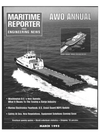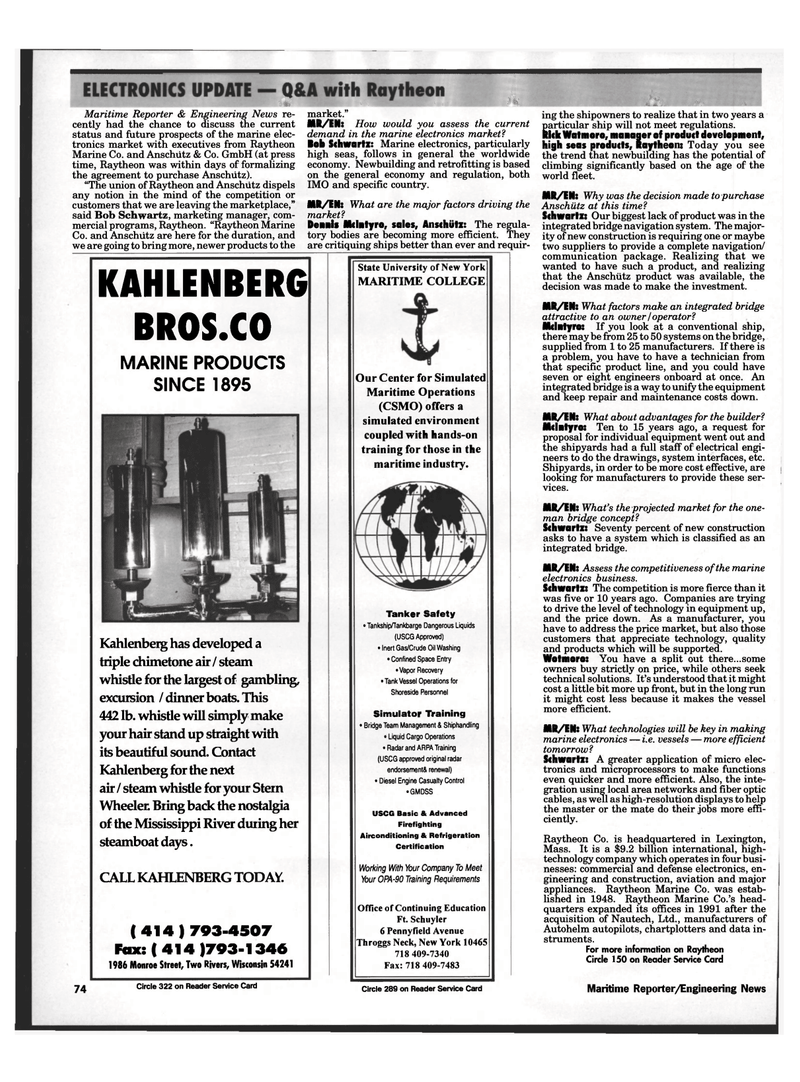
Page 74: of Maritime Reporter Magazine (March 1995)
Read this page in Pdf, Flash or Html5 edition of March 1995 Maritime Reporter Magazine
Maritime Reporter & Engineering News re- cently had the chance to discuss the current status and future prospects of the marine elec- tronics market with executives from Raytheon
Marine Co. and Anschiitz & Co. GmbH (at press time, Raytheon was within days of formalizing the agreement to purchase Anschiitz). "The union of Raytheon and Anschiitz dispels any notion in the mind of the competition or customers that we are leaving the marketplace," said Bob Schwartz, marketing manager, com- mercial programs, Raytheon. "Raytheon Marine
Co. and Anschiitz are here for the duration, and we are going to bring more, newer products to the market."
MR/EN: How would you assess the current demand in the marine electronics market?
Bob Schwartz: Marine electronics, particularly high seas, follows in general the worldwide economy. Newbuilding and retrofitting is based on the general economy and regulation, both
IMO and specific country.
MR/EN: What are the major factors driving the market?
Dennis Mclntyro, sales, Anschiitz: The regula- tory bodies are becoming more efficient. They are critiquing ships better than ever and requir-
KAHLENBERG
BROS.CO
MARINE PRODUCTS
SINCE 1895
Kahlenberg has developed a triple chimetone air / steam whistle for the largest of gambling, excursion / dinner boats. This 442 lb. whistle will simply make your hair stand up straight with its beautiful sound. Contact
Kahlenberg for the next air / steam whistle for your Stern
Wheeler Bring back the nostalgia of the Mississippi River during her steamboat days.
CALL KAHLENBERG TODAY. (414)793-4507
Fax: (414 )793-1346 1986 Monroe Street, Two Rivers, Wisconsin 54241
State University of New York
MARITIME COLLEGE
Our Center for Simulated
Maritime Operations (CSMO) offers a simulated environment coupled with hands-on training for those in the maritime industry.
Tanker Safety • Tankshipfiankbarge Dangerous Liquids (USCG Approved) • Inert Gas/Crude Oil Washing • Confined Space Entry •Vapor Recovery • Tank Vessel Operations for
Shoreside Personnel
Simulator Training • Bridge Team Management & Shiphandling • Liquid Cargo Operations • Radar and ARPA Training (USCG approved original radar endorsements renewal) • Diesel Engine Casualty Control •GMDSS
USCG Basic & Advanced
Firefighting
Airconditioning & Refrigeration
Certification
Working With Your Company To Meet
Your OPA-90 Training Requirements
Office of Continuing Education
Ft. Schuyler 6 Pennyfield Avenue
Throggs Neck, New York 10465 718 409-7340
Fax: 718 409-7483 ing the shipowners to realize that in two years a particular ship will not meet regulations.
Rick Watmoro, manager of product development, high seas products, Raytheon: Today you see the trend that newbuilding has the potential of climbing significantly based on the age of the world fleet.
MR/EN: Why was the decision made to purchase
Anschiitz at this time?
Schwartz: Our biggest lack of product was in the integrated bridge navigation system. The major- ity of new construction is requiring one or maybe two suppliers to provide a complete navigation/ communication package. Realizing that we wanted to have such a product, and realizing that the Anschiitz product was available, the decision was made to make the investment.
MR/EN: What factors make an integrated bridge attractive to an owner I operator?
Mclntyro: If you look at a conventional ship, there may be from 25 to 50 systems on the bridge, supplied from 1 to 25 manufacturers. If there is a problem, you have to have a technician from that specific product line, and you could have seven or eight engineers onboard at once. An integrated bridge is a way to unify the equipment and keep repair and maintenance costs down.
MR/EN: What about advantages for the builder ?
Mclntyro: Ten to 15 years ago, a request for proposal for individual equipment went out and the shipyards had a full staff of electrical engi- neers to do the drawings, system interfaces, etc.
Shipyards, in order to be more cost effective, are looking for manufacturers to provide these ser- vices.
MR/EN: What's the projected market for the one- man bridge concept?
Schwartz: Seventy percent of new construction asks to have a system which is classified as an integrated bridge.
MR/EN: Assess the competitiveness of the marine electronics business.
Schwartz: The competition is more fierce than it was five or 10 years ago. Companies are trying to drive the level of technology in equipment up, and the price down. As a manufacturer, you have to address the price market, but also those customers that appreciate technology, quality and products which will be supported.
Wotmoro: You have a split out there...some owners buy strictly on price, while others seek technical solutions. It's understood that it might cost a little bit more up front, but in the long run it might cost less because it makes the vessel more efficient.
MR/EN: What technologies will be key in making marine electronics — i.e. vessels — more efficient tomorrow?
Schwartz: A greater application of micro elec- tronics and microprocessors to make functions even quicker and more efficient. Also, the inte- gration using local area networks and fiber optic cables, as well as high-resolution displays to help the master or the mate do their jobs more effi- ciently.
Raytheon Co. is headquartered in Lexington,
Mass. It is a $9.2 billion international, high- technology company which operates in four busi- nesses: commercial and defense electronics, en- gineering and construction, aviation and major appliances. Raytheon Marine Co. was estab- lished in 1948. Raytheon Marine Co.'s head- quarters expanded its offices in 1991 after the acquisition of Nautech, Ltd., manufacturers of
Autohelm autopilots, chartplotters and data in- struments.
For more information on Raytheon
Circle 150 on Reader Service Card 74 Circle 322 on Reader Service Card Circle 289 on Reader Service Card Maritime Reporter/Engineering News

 73
73

 75
75
